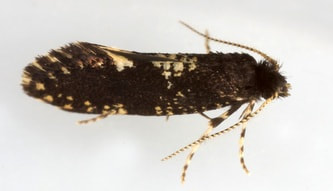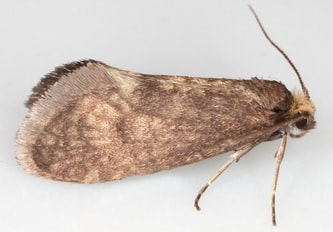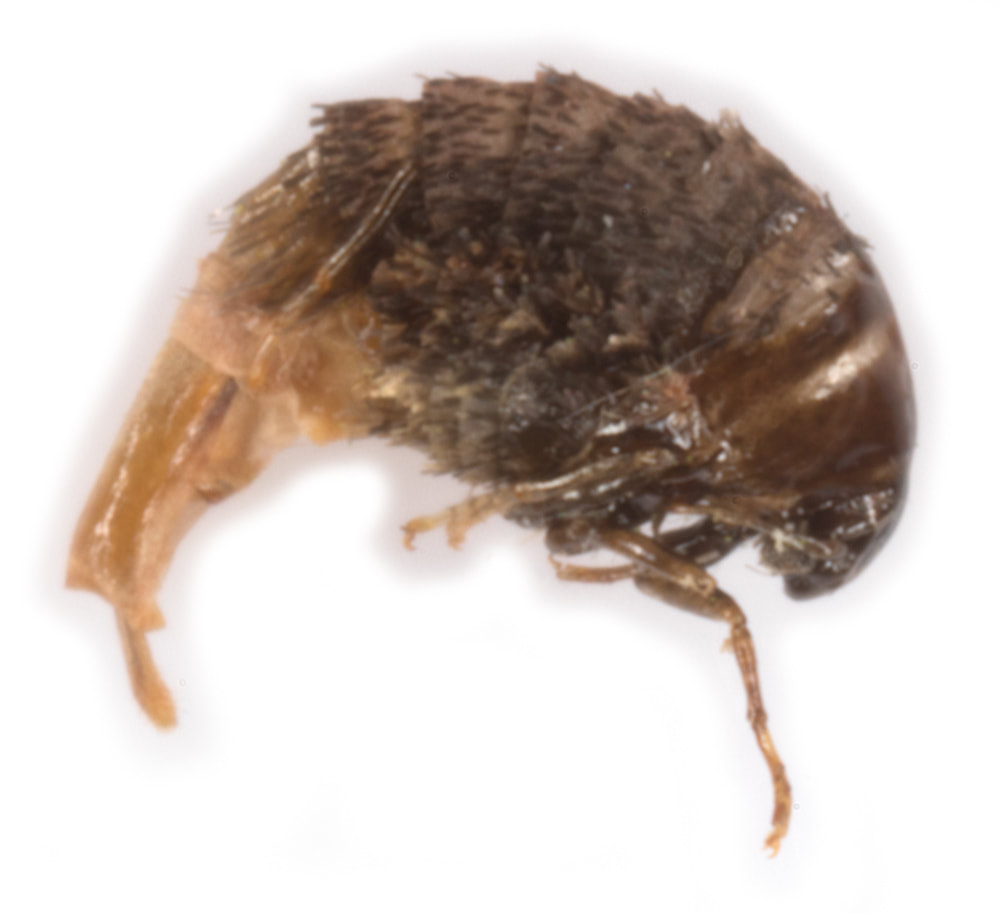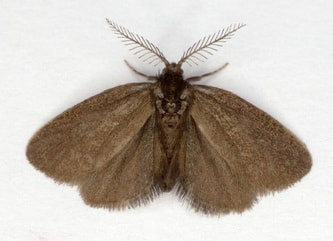Females apterous in all except Narycia duplicella and Diplodoma laichartingella
3 species parthenogenetic with females developing from unfertilised eggs and the males being unknown in Britain - Dahlica triquetrella, Dahlica lichenella, & Luffia ferchaultella
Larvae are case-bearers
Adults do not feed and do not usually survive more than a day for males, though the females may live longer.
ws: 7-28mm; Maxillary palps obsolete; Proboscis obsolete; Ocelli present, separated from eye-margins by width of an antenna, or absent
Hindwings as broad as forewings; Hindtibia long-haired.
(I have not yet determined features separating the subfamilies).
3 species parthenogenetic with females developing from unfertilised eggs and the males being unknown in Britain - Dahlica triquetrella, Dahlica lichenella, & Luffia ferchaultella
Larvae are case-bearers
Adults do not feed and do not usually survive more than a day for males, though the females may live longer.
ws: 7-28mm; Maxillary palps obsolete; Proboscis obsolete; Ocelli present, separated from eye-margins by width of an antenna, or absent
Hindwings as broad as forewings; Hindtibia long-haired.
(I have not yet determined features separating the subfamilies).
Subfamily: Naryciinae
Tribe: Naryciini
|
Diplodoma
Female fully-winged, antenna ciliate, ocelli present, labial palp 3-segmented with a hair-tuft; foretibia with 1 spur. 001 Diplodoma laichartingella
(Yellow-headed Bagworm) ws10-15mm; May-Jun; local in wooded areas throughout UK. |
Narycia
Female fully-winged, antenna ciliate, ocelli absent, labial palp 3-segmented, foretibia without spurs but with long tuft of dark scales. 002 Narycia duplicella
(White-speckled Bagworm) |
Tribe: Dahlicini
Dahlica (3S)
Parthenogenetic in 2 species. Male: antenna ciliate, ocelli absent, labial palp 2-segmented, foretibia without spurs.
Female: apterous, antenna simple, 12-26-segmented; labial palp reduced to 1 minute segment; legs short, spurs variable.
Parthenogenetic in 2 species. Male: antenna ciliate, ocelli absent, labial palp 2-segmented, foretibia without spurs.
Female: apterous, antenna simple, 12-26-segmented; labial palp reduced to 1 minute segment; legs short, spurs variable.
|
003 Dahlica triquetrella
(Narrow Lichen Case-bearer) Only the apterous female occurs in UK; Mar-Apr; remains in larval case to lay eggs; RDB has been recorded in Kent and Essex |
004 Dahlica inconspicuella
(Lesser Lichen Case-bearer) ws9-13mm; Mar-Apr; NS-A in England |
005 Dahlica lichenella
(Lichen Case-bearer) Only the apterous female occurs in UK; Mar-Apr; NS-A in S.England and S.Scotland |
Subfamily: Taleporiinae
|
Taleporia
Male: antenna ciliate, ocelli present, labial palp 3-segmented, foretibia with 1 spur. Female: apterous, antenna simple, labial palp reduced to 1 segment, legs without spurs. 006 Taleporia tabulosa
(Brown Bagworm) |
Bankesia
Male: antenna ciliate with the cilia in rings at base of each segment; ocelli present; labial palp 3-segmented, long; foretibia with very small spur. Female: apterous, antenna short with 5-6 segments, ocelli absent, labial palp reduced to 1 segment, legs without spurs, tarsal segments reduced. 007 Bankesia conspurcatella
(Scarce Bagworm) ws: 11-15mm; Mar-Apr; RDB - rare and local in S.England |
Subfamily: Psychinae
Males: with bipectinate antenna, ocelli absent, labial palp reduced, foretibia with 1 long spur - the insertion position of which is used in separation of genera. Females: apterous, antenna simple.
Males: with bipectinate antenna, ocelli absent, labial palp reduced, foretibia with 1 long spur - the insertion position of which is used in separation of genera. Females: apterous, antenna simple.
|
Luffia (2S)
Female with tarsal segments reduced |
Bacotia
Male foretibial spur inserted at 1/2; Female with tarsal segments reduced |
|
Proutia
Male: foretibial spur inserted at 1/3 from base. Female spurs?* (tarsal segments?) 011 Proutia betulina
(Birch Bagworm) ws11-14mm; Jun-Jul; RDB - local in SE.England |
Psyche 2S (1EX)
Male: foretibial spur inserted at 1/5 from base. Female legs?** 012 Psyche casta
(Common Bagworm) |
013 Psyche crassiorella
(Scarce Grass Bagworm) ws13-17mm; Jun-Jul; Extinct in GB, formerly very local in SE.England |
*MBGBI2 states that Proutia females have legs without spurs, but in its description of female Proutia betulina it states that "the female has 2 to 5 tibial spurs"!
** MBGBI2 states that Psyche females have normally developed legs, but in its description of female Psyche casta it states "legs with 3-5 tarsal segments".
** MBGBI2 states that Psyche females have normally developed legs, but in its description of female Psyche casta it states "legs with 3-5 tarsal segments".
Subfamily: Epichnopteriginae
|
Epichnopterix
Male: antennae bipectinate; ocelli absent; labial palp reduced; foretibia without spur Female: apterous, eyes minute, antennae absent, legs absent or rudimentary |
Whittleia
Not distinguished from Epichnopterix in MBGBI2 |
|
|
014 Epichnopterix plumella.
(Plumed Bagworm) ws: 10-14mm; Apr-Jun; local in meadows and moorland of South England and Wales. |
015 Whittleia retiella.
(Netted Bagworm) ws: 8-10mm; May-Jun; larval case on common saltmarsh grass (Puccinellia maritima); RDB on saltmarshes of SE.England. |
|
Subfamily: Oiketicinae
Males with bipectinate antennae, ocelli absent, labial palp reduced. Females vermiform: apterous, antennae absent, legs absent.
Males with bipectinate antennae, ocelli absent, labial palp reduced. Females vermiform: apterous, antennae absent, legs absent.
|
Acanthopsyche
Foretibia with very long spur,midtibia and hindtibia without spurs (labial palp may be as stated for other genera but not clear in MBGBI2) |
Pachythelia
Foretibia with long spur, midtibia and hindtibia without spurs; labial palp with 1-segment and a hair-tuft. |
Sterrhopterix
Foretibia without spurs, midtibia and hindtibia with very short spurs; labial palp with 1 segment and a hair-tuft. |
|
016 Acanthopsyche atra
(Lesser Heath Bagworm) ws: 16-22mm; May-Jun; RDB - local on heath and moorland. |
017 Pachythelia villosella
(Large Heath Bagworm) ws: 22-28mm; Jun-Jul; RDB heaths of Dorset and Hampshire |
018 Sterrhopteryx fusca
(Dusky Heath Bagworm) ws18-25mm; Jun-Jul; RDB - very local in England and Wales |
All images © Chris Lewis




